- Home
- The Spring Garden
- Spring Perennials E-L
Spring Perennials E - L
Choose your favorite spring perennials here. Delightful epimediums, charming geraniums, gorgeous irises, and more!
Our list of favorites continues here . . .
Epimediums
Epimediums are becoming more and more popular, and no wonder, as there are not many spring perennials that can be depended upon to perform better in dry shade than epimediums. Though delicate-looking, these are pretty tough plants, and make wonderful ground covers. Give them woodsy, humusy soil and morning sun and they will multiply via rhizomatous roots. More and more species and cultivars are becoming available, as their popularity grows. Flower colors range from pure white to yellow, orange, pink, red, and lilac; and rise above the leaves on wiry stems. The leathery leaves are usually an elongated heart-shape, and often tinged with red-bronze when they emerge in spring, and some species have wavy, spiny edges. Epimediums have the added advantage of being extraordinarily pest-free, and critter resistant, too.
Epimedium ‘Amber Queen,’ hybrid barrenwort, Zones 5-8. ‘Amber Queen’ has a long bloom period from March through the summer, even into fall—it just keeps on throwing sprays of golden flowers. Plant evergreen ‘Amber Queen’ in semi-shaded location where it can spread to make a lovely ground cover. Little maintenance is required—just trim off the old leaves in late winter before the new foliage begins to emerge. A designee of the prestigious RHS Award of Garden Merit.
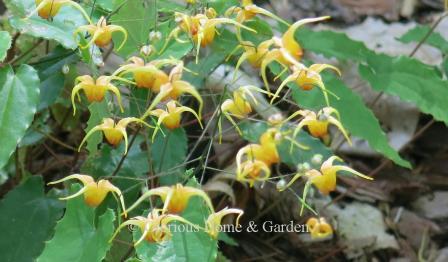 Epimedium 'Amber Queen'
Epimedium 'Amber Queen'Epimedium ‘Domino,’ hybrid barrenwort or fairy wings, Zones 5-8. ‘Domino’ is a remarkable cultivar, producing masses of white-spurred flowers tinged with raspberry that look like a flock of flying birds, from the end of February to the end of May in my 8a garden. This one can get about 24” h., but the flowers are held nicely above the foliage. As with many epimediums, the leaves start out splotched with bronze, then turn green. ‘Domino’ can even take on bright red colors in the fall under the right conditions. Even though evergreen, it is best to trim off the old leaves and stems before the new leaves emerge in mid-winter for best appearance.
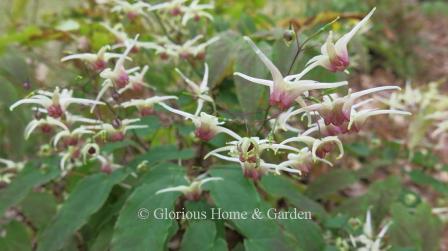 Epimedium 'Domino'
Epimedium 'Domino'Epimedium ‘Pink Champagne,’ hybrid barrenwort, Zones 5-8. ‘Pink Champagne’ is another outstanding cultivar. It covers itself with rosy-pink flowers with paler spurs. Simply an excellent choice for a semi-shady woodland garden. Evergreen. Another RHS Award of Garden Merit winner.
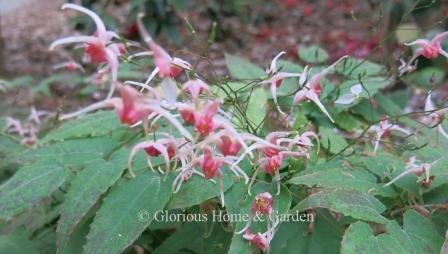 Epimedium 'Pink Champagne'
Epimedium 'Pink Champagne'Epimedium grandiflorum, longspur or large-flowered barrenwort or bishop's hat, Zones 5-8. If you have an area of dry shade under trees in your garden, epimediums are one of the most rewarding spring perennials you can grow. The species, E. grandiflorum, has larger flowers than most epimediums. The flowers have rosy inner sepals and creamy-white inner petals with long spur and float above the bronze-tinged new foliage. Cultivars include 'Album' with pure white flowers, 'Lilifee' with violet flowers, 'Rose Queen' with rose-red flowers, and 'Silver Queen' with pink-tinged white flowers.
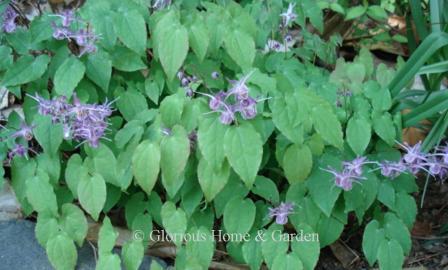 Epimedium grandiflorum 'Lilifee'
Epimedium grandiflorum 'Lilifee'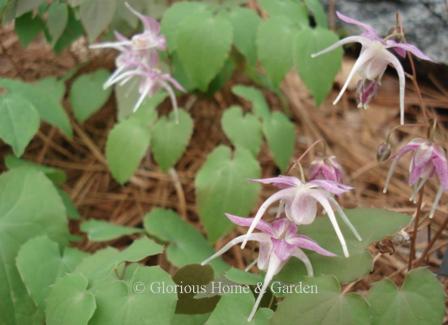 Epimedium grandiflorum 'Silver Queen'
Epimedium grandiflorum 'Silver Queen'Epimedium x omeiense, fairy wings, Zones 5-8. This long-spurred barrenwort looks a squadron of little birds in flight (or maybe crawling spiders!) rising above the leaves in spring. The violet flowers rise on 24" stems making it taller than most epimediums. 'Akame' has raspberry flowers tipped with yellow; 'Razzleberry' has raspberry flowers edge in white. Evergreen.
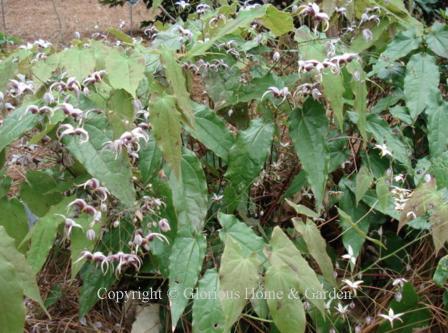 Epimedium omeiense
Epimedium omeienseEpimedium x perralchicum, fairy wings, Zones 5-8. This epimedium is a hybrid between E. perralderianum and E. pinnatum ssp. colchicum. The small yellow flowers are borne in sprays, are nearly spurless, and the open petals resemble tiny narcissus. The variety 'Frohnleiten' is renowned for its beautiful reddish evergreen foliage.
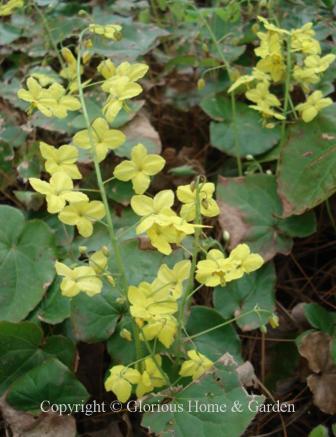 Epimedium x perralchicum
Epimedium x perralchicumEpimedium x rubrum, red barrenwort, Zones 4-9. A beautiful epimedium to use as a ground cover in a shady area. The heart-shaped leaves open in spring flushed with red which changes to green. The flowers have red sepals which open like wings exposing the true flowers of light yellow. If the leaves look tattered by the end of winter, just cut them off and fresh new foliage will soon emerge. It spreads by rhizomes and will soon form a lovely clump. ‘Galadriel’ is a lovely cultivar of E. x rubrum with darker red flowers.
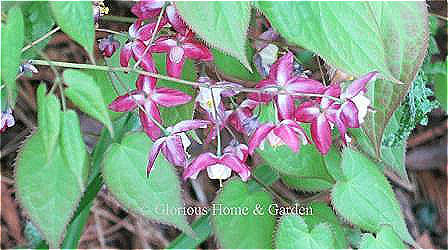 Epimedium x rubrum
Epimedium x rubrumEpimedium sempervirens, barrenwort or fairy wings, Zones 5-8. Large white flowers with spurs and a more open cup than E. grandiflorum. Semi-evergreen to evergreen. One great new cultivar, 'Cherry Hearts,' has white flowers, but the foliage is what is special. New leaves emerge red in spring and change to green with red margins that last through the season.
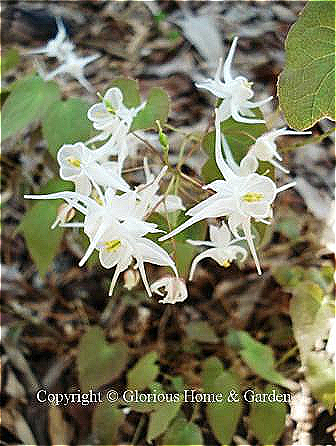 Epimedium sempervirens
Epimedium sempervirensEpimedium stellulatum 'Long Leaf Form,' star-shaped fairy wings, Zones 4-8. This delightful spring perennial has long, narrow leaves with spiny, wavy edges. The tiny white and yellow flowers are borne on tall sprays above the evergreen foliage.
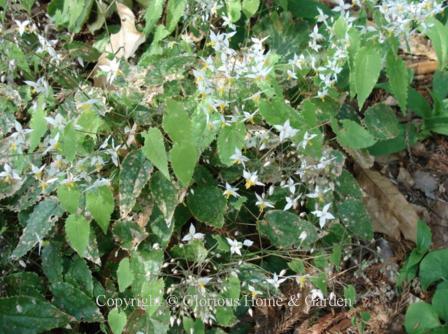 Epimedium stellulatum
Epimedium stellulatumEpimedium x versicolor ‘Sulphureum,’ bishop’s hat or bicolor barrenwort, Zones 5-8. ‘Sulphureum’ eagerly puts out its yellow petals with pinkish spurs and paler yellow sepals in early March in my Zone 8a garden. Best grown in partial shade with organically rich soil and even moisture, though it will tolerate some dry conditions. In late winter, shear off the old tattered foliage to best show off the reddish new foliage and flowers. Evergreen.
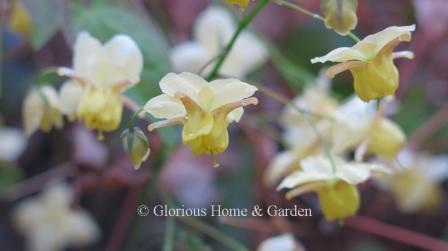 Epimedium x versicolor 'Sulphureum'
Epimedium x versicolor 'Sulphureum'Epimedium x youngianum, Young's barrenwort, Zones 5-8. This is a hybrid cross between E. diphyllum and E. grandiflorum, and has white to pink flowers. Selections include 'Azusa' with white flowers and silvery veining in the leaves; 'Niveum,' known as snowy barrenwort with dainty pure white flowers; 'Roseum,' lavender-pink; and 'Yenomoto,' with rosy buds opening white and larger than 'Niveum.' Deciduous.
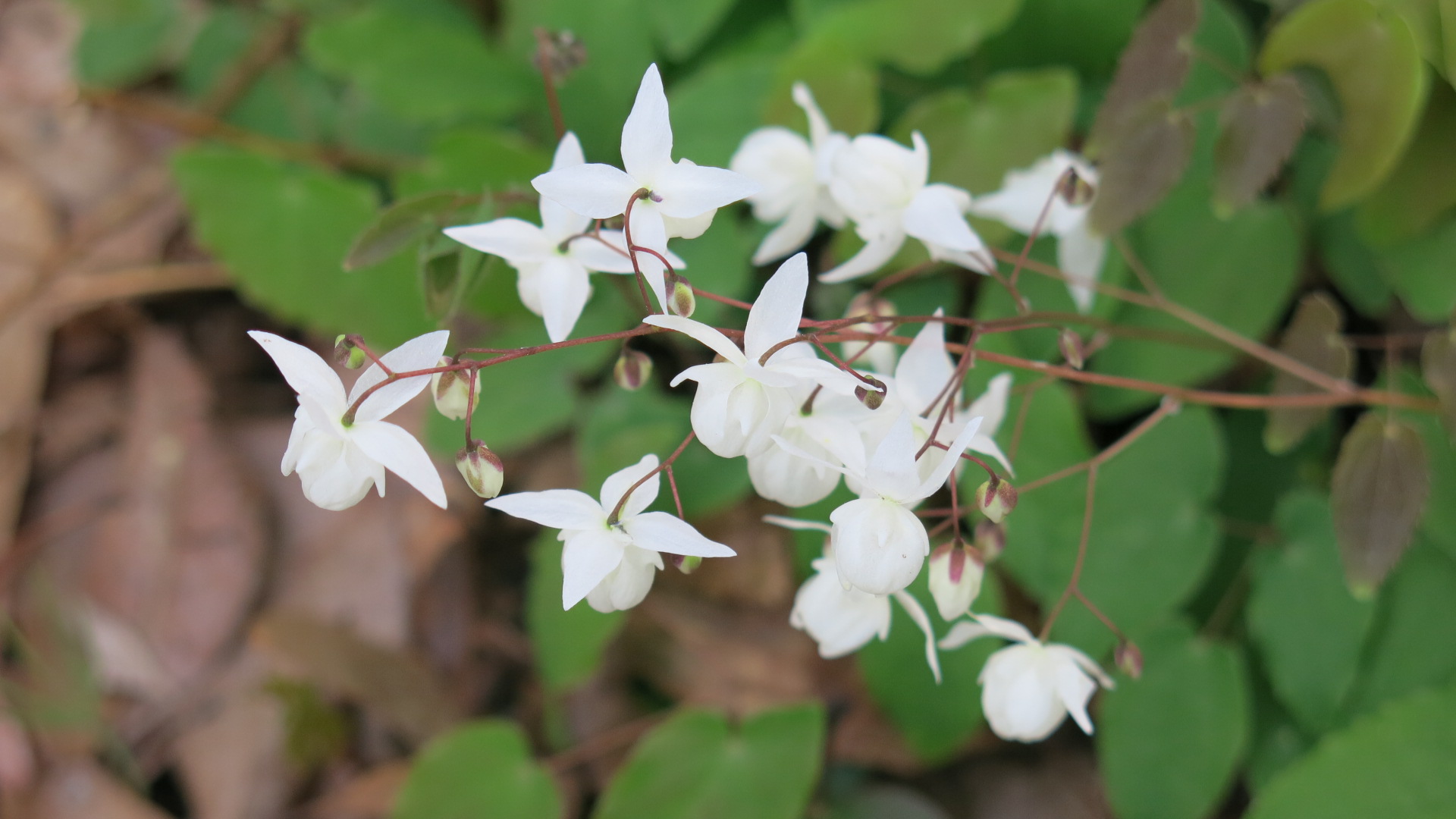 Epimedium x youngianum 'Niveum'
Epimedium x youngianum 'Niveum'Epimedium x warleyense, Warley’s barrenwort, Zones 4-8. Warley’s barrenwort originated in England as a chance cross, and has unique orange coloration.
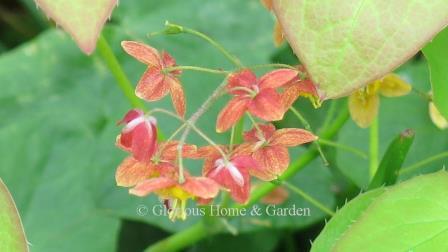 Epimedium x warleysense 'Orange Queen'
Epimedium x warleysense 'Orange Queen'Erigeron karviskianus, Mexican daisy or fleabane, Zones 6-9. If you visit gardens in England in spring or summer, you will find this charming spring perennial everywhere--decorating walks, steps, walls, raised beds, and containers. It is easy to grow from seed, blooms profusely, and self-seeds readily. The tiny daisies open white with yellow centers and fade to rose and purple. Erigeron requires full sun to light shade, good drainage, and fertile soil. The only maintenance is to deadhead to promote rebloom and tidy up in the fall. A lovely way to add charm and cheerfulness to the garden.
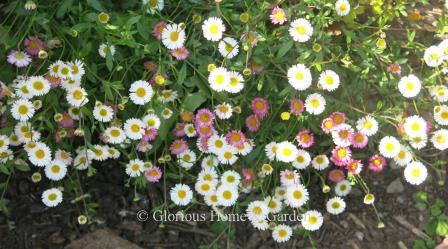 Erigeron karvinskianus
Erigeron karvinskianusErysimum linifolium, flax wallflower, Zones 5-9. Flax wallflower is one of those spring perennials that you must include in your garden. It has a long flowering season from winter into spring, but will only last a few years in the garden. The gray-green foliage is evergreen. One particularly excellent new variety is 'Jenny Brook' with multi-colored flowers of purple to mauve to apricot. 'Bowles' Mauve' with purple blooms is also very popular, and 'Fragrant Star' with scented yellow flowers and variegated foliage is striking.
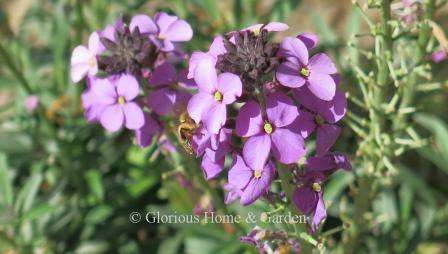 Erysimum linifolium 'Bowles' Mauve'
Erysimum linifolium 'Bowles' Mauve'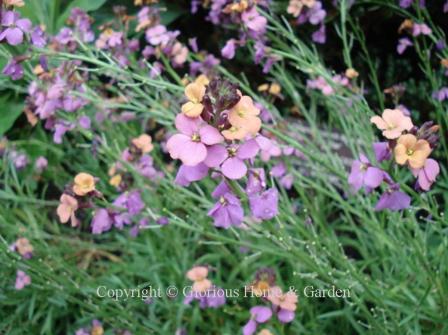 Erysimum linifolium 'Jenny Brook'
Erysimum linifolium 'Jenny Brook'Eschscholzia californica, California poppy, Zones 6-10. This spring perennial brings bright drops of sunshine to the garden blooming most heavily in spring and sporadically throughout the summer. Easy to grow (and can be weedy in certain conditions) the California poppy is perennial in warmer climates and is used as an annual in colder climates. The ferny blue-green foliage is attractive and yellow-to-orange cups are eye=catching. This North American native is the state flower of California.
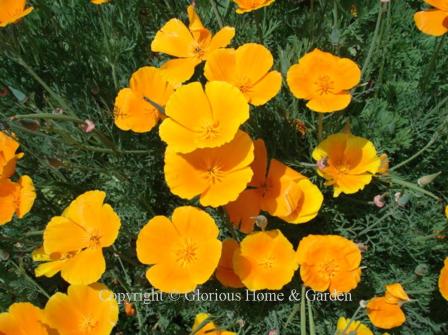 Eschscholzia californica
Eschscholzia californicaEuphorbias
The only euphorbias most people are familiar with are the Christmas-time poinsettias, which are tropical. But there are many others that make great garden plants. Anything that will start blooming early in spring and bloom for a long period is welcome in my garden! It is fun to watch the new growth appear as early as January (in my 8a zone) showing that spring is on the way, but not only that—they provide great structure to the garden as well. The new growth can be pinkish or reddish on some species followed by chartreuse bracts (there are white, orange, and red ones, too). They mingle well with spring bulbs, and make good companions with sedums, salvias, alliums, heucheras, and lavender. You may notice as you pass by a slight oniony smell—not unpleasant—and I expect it explains why deer and rabbits avoid it.
At the end of the season, when the old stems begin to look tired and new growth appears at the base of the plants, you can removed the old stems. But be careful when you cut the stems because they secrete a milky sap that can cause irritation to skin or eyes, so always were gloves when working with them and clean your tools afterwards.
Euphorbia amygdaloides, wood spurge, Zones 5-7. One of the earliest spring perennials to bloom, wood
spurge announces the awakening of the garden and produces long-lasting
chartreuse bracts that are really eye-catching. The evergreen foliage is
attractive all winter and some have red or colored stems and leaves. 'Ruby Glow,' shown below, grows 12-18"
and has dark green foliage with red new growth.
The contrast with the yellow bracts is wonderful.
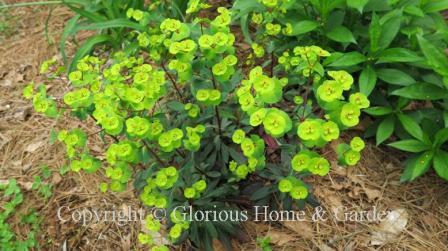 Euphorbia amygdaloide 'Ruby Glow'
Euphorbia amygdaloide 'Ruby Glow'Euphorbia amygdaloides var. robbiae, Robb’s spurge, Zones 6-9. Robb’s spurge is a beautiful woodland ground cover with dark green evergreen foliage. It has greenish-yellow bracts in spring. However, because it spreads by underground rhizomes, it can spread quickly, so it is important to plant it where it has room to roam without overtaking its neighbors. It also self-seeds readily, but that is easily controlled by removed the flowering stems before the seeds can ripen. Grow in shady to semi-shady areas with average moisture—it is a good choice for dry woodland conditions.
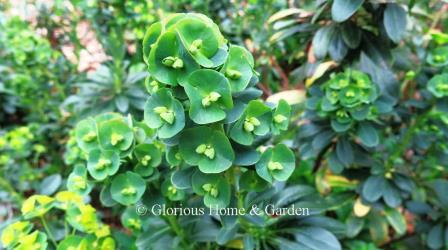 Euphorbia amygdaloides var. robbiae
Euphorbia amygdaloides var. robbiaeEuphorbia characias, Mediterranean spurge, Zones 6-8. This is a large plant that will not be ignored. It forms large clumps from 3 to 5’ high with woody stems. The blue-green foliage with yellow-green bracts is striking and long-lasting in the garden. Very welcome for its late winter/early spring bloom. Grow in full sun with well-drained soil. Smaller gardens will want to seek out E. characias subsp wulfenii at 2-3’ high, or some of the smaller hybrids like ‘Galaxy Glow,’ ‘Glacier Blue,’ or ‘Humpty Dumpty.’
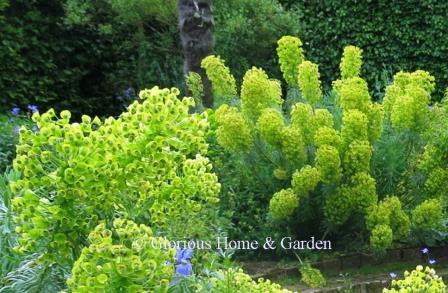 Euphorbia characias
Euphorbia characias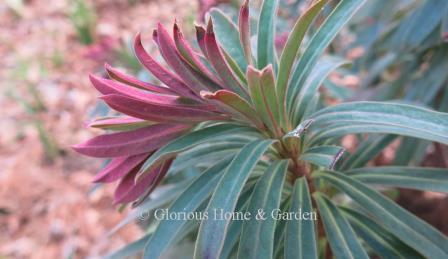 Euphorbia 'Galaxy Glow'
Euphorbia 'Galaxy Glow'Euphorbia griffithii, Griffith’s spurge or milkwort, Zones 5-7. This is an exciting species because it exhibits orange to red-orange bracts unlike the usual yellow or chartreuse. Grows best in full sun to part shade and moist soil, and has a long bloom period. ‘Dixter,’ below at great plantsman Christopher Lloyd’s Great Dixter Garden in Kent, England, really caught my eye with its bright orange bracts and tiny yellow flowers in the center. Another good cultivar is ‘Fireglow’ with even deeper red-orange bracts.
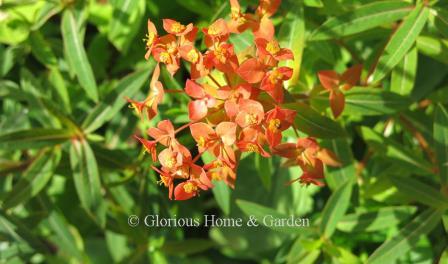 Euphorbia griffithii 'Dixter'
Euphorbia griffithii 'Dixter'Euphorbia x martinii, Martin’s spurge, Zones 5-9. ‘Ascot Rainbow’ is an stunning cultivar of euphorbia, distinguished by its variegated foliage of yellow and green stripes with pink new growth. .Yellow and green bracts soon appear centered by the tiny red flowers. As with all euphorbias they like sun to part shade, fertile, fast-draining soil that is moist, but not soggy. Another variety, ‘Tiny Tim,’ is a dwarf cutie that grows about 1’ x 1’ and has dark green leaves flushed with burgundy and burgundy stems followed by lime green bracts centered by tiny red flowers.. Cut back old stems in summer when new growth appears at the base of the plant
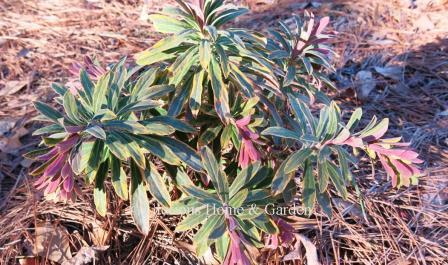 Euphorbia x martinii 'Ascot Rainbow'
Euphorbia x martinii 'Ascot Rainbow'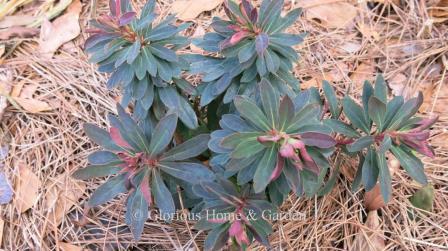 Euphorbia x martinii 'Tiny Tim'
Euphorbia x martinii 'Tiny Tim'Galium odoratum, sweet woodruff, Zones 4-7. In my Zone 7b garden, sweet woodruff likes
some shade and ample moisture, perhaps that it why it has not done well for me
here with the southern heat and drought.
I love it though, for its whorls of green leaves that look like
Elizabethan collars, its fragrance and charming white flowers. This was used as a "strewing herb" in medieval and Elizabethan times along with lavender, mints, chamomile, roses, and others to mask foul odors and sweeten the air.
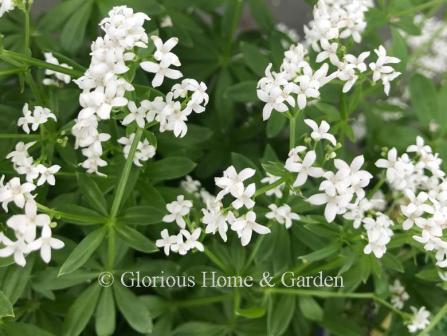 Galium odoratum
Galium odoratumHardy Geraniums
Hardy geraniums are lovely spring perennials and some continue on throughout the summer. These are the "real" geraniums, not the familiar summer flower box plants called geraniums, but which are actually pelargoniums. I have listed the very popular hybrid cultivar 'Rozanne' under Summer Perennials because of its long bloom period.
Geranium x cantabrigiense, Cambridge geranium, Zones 5-7. An evergreen mounding spring perennial that grows from 6-12” tall with purple flowers. The ‘Biokovo’ cultivar has very pale pink, almost white flowers with pink stamens, and was named the 2015 Perennial Plant of the Year.
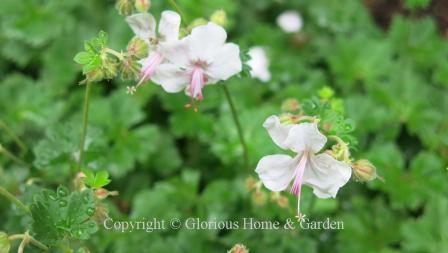 Geranium x cantabrigiense 'Biokovo'
Geranium x cantabrigiense 'Biokovo'Geranium cinereum, grayleaf geranium, Zones 5-7. Geranium cinereum is an excellent low-growing spring perennial for the front of the border or a rock garden, requiring full sun and good drainage. 'Ballerina,' with soft pink veined flowers is shown below.
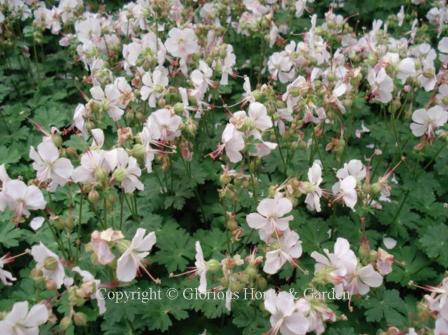 Geranium cinereum 'Ballerina'
Geranium cinereum 'Ballerina'Geranium macrorrhizzum, bigroot geranium, Zones 3-8. Bigroot geranium spreads by thick rhizomes (hence the common name), and thus it makes a nice dense ground cover, and the rhizomes help the plant endure periods of drought. The fragrant pinkish-purple flowers bloom in mid-to-late spring and sporadically in the summer. And, as a bonus, the lobed foliage is nicely fragrant, too, and turns reddish in the fall. Add that it is also deer-resistant and you’ve got a winner! ‘Spessart’ has fragrant white flowers from puffy buds that look like pink gooseberries; the foliage is exceptionally fragrant, too!
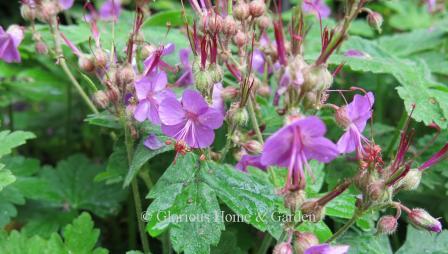 Geranium macrorrhizum
Geranium macrorrhizum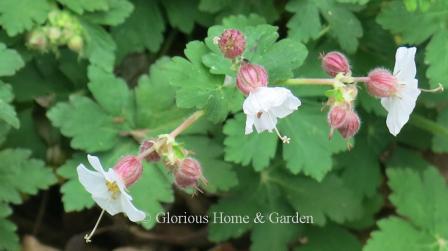 Geranium macrorrhizum 'Spessart'
Geranium macrorrhizum 'Spessart'Geranium sanguineum, bloody cranesbill, Zones 3-8. Bloody cranesbill gets it’s intriguing common name from the fact that the deeply divided leaves turn a brilliant red in autumn, and the seed capsule resembles a crane’s bill. Whatever the nomenclature, the bloody cranesbill is a fine spring perennial for the border forming low 12”mounds.
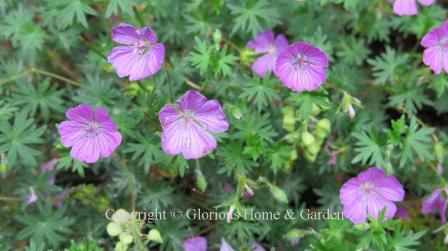 Geranium sanguineum 'John Elsley'
Geranium sanguineum 'John Elsley'Hesperis matronalis, dame's rocket, Zones 3-8. Actually a biennial, dame's rocket shoots up tall stalks of purple or white flowers in the late spring that make me think of a tall, skinny phlox. It is charming in the back of the border or in a meadow where it will self-seed and return for years. Lovely fragrance too! It likes a bit of shade and evenly moist soil. It is said to be invasive, but proliferation can be controlled by removing the flowerheads after blooming before they can set seed.
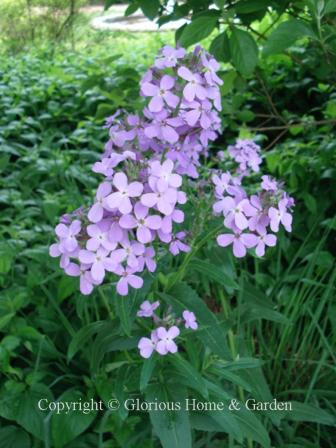 Hesperis matronalis
Hesperis matronalisHeucheras and Heucherellas
Heuchera americana, coral bells or alumroot,
Zones 4-9. Heucheras are great plants to
grow for foliage leaf color. The flowers
are a bonus, though they are tiny and arise on tall, narrow spikes. There are so many great hybrids developed
from this North American native and other species that you simply must choose
the colors that will work best in your garden with your other perennials. There are green-leafed ones, purple-leafed
ones, almost black ones (like ‘Obsidian’ below), bronzy-leafed ones, silvery-leafed
ones (like ‘Silver Lode’ below), golden-leafed ones, peachy-leafed ones,
coral-leafed ones, red-leafed ones, and mottled ones--something to fit in any color scheme you choose. Perfect for a shady garden in combination
with hostas, tiarellas, crested irises, cimicifugas, bleeding hearts and
others. Also wonderful in
containers. Divide about every 3 years
when the plant becomes woody to rejuvenate it. 3 years when the plant
becomes woody to rejuvenate it.
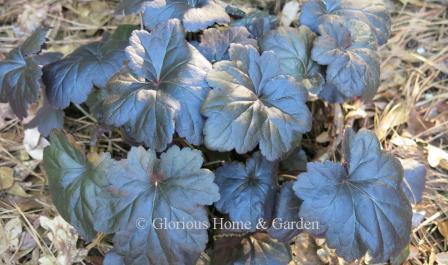 Heuchera x 'Obsidian'
Heuchera x 'Obsidian'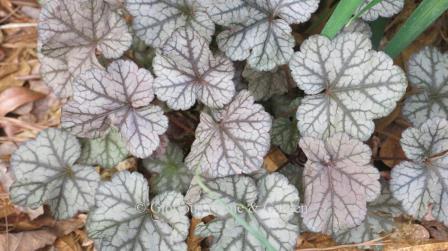 Heuchera x 'Silver Lode'
Heuchera x 'Silver Lode'X Heucherella, foamy bells, Zones 4-9. Heucherellas are intergenetic crosses between heucheras and tiarellas combining characteristics of both parents creating even more striking leaf colors and shapes, mounding growth habit, and flowers from the tiarella parent in white or pink. Leaf colors include chartreuse, green, red, pink, peach, bronze, purple, and bi-colors, and make great additions to borders and in containers. Grow heucherellas in the same conditions as heucheras—namely semi-shade and moist, well-drained, organically rich soil.
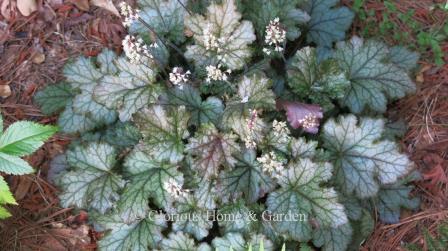 X Heucherella 'Cracked Ice'
X Heucherella 'Cracked Ice'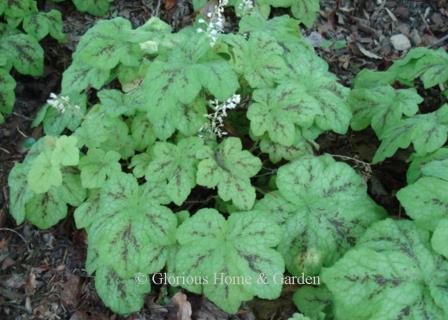 X Heucherella 'Yellowstone Falls'
X Heucherella 'Yellowstone Falls'Iberis sempervirens, candytuft, Zones 3-8. Candytuft makes a great ground cover. It's pure white flowers are indispensable in the spring and make a great foil for spring bulbs to push through. When the bloom period is finished, the evergreen foliage stays neat and tidy all year.
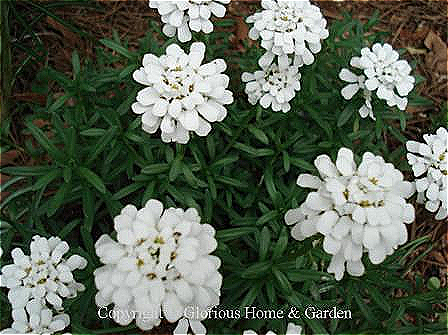 Iberis sempervirens
Iberis sempervirensIrises
Among the many candidates for the title of "Queen of Spring Perennials," the iris is second to none for beauty of form and color range. There are so many different types of irises with different characteristics that they deserve a section of their own. Rhizomatous irises grow from roots and tubers, and are further divided into bearded and beardless groups.
Bearded irises include aril and arilbred irises, I. germanica (the German bearded irises everyone is familiar with), I. albicans (cemetery iris, I germanica var. florentina (orris iris), and I pallida (sweet iris).
Beardless irises include I. cristata (crested iris), I. ensata (Japanese iris), I. japonica, Iris x louisiana hybrids, I pseudocorus (yellow flag iris), I sibirica (Siberian iris), and I. tectorum (Japanese roof iris), and others.
Other irises grow
from true bulbs such as I danfordiae,
I reticulata, Iris latifolia (English iris), and Iris x hollandica (Dutch
iris). Click here for irises that grow from true bulbs.
Kniphofia uvaria, torchlily or red-hot poker, Zones 5-8. Tall spires of red-orange or yellow make this a great spring perennial to accent the sunny border. Grow in full sun with good drainage.
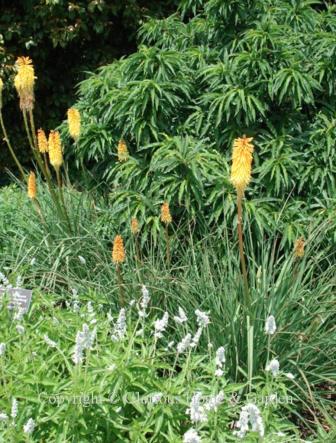 Kniphofia uvaria
Kniphofia uvariaLamium maculatum, spotted dead nettle, Zones 3-8. A good spreading ground cover that is useful for partial shady to shady areas—it does especially well in the Northeast and Northwest. Silvery leaved varieties such as ‘Beacon Silver’ help light up dark areas and even do well under trees. Other cultivars include ‘Lemon Frost’ with golden leaves contrasting with pink flowers, ‘Purple Dragon’ with silver leaves and purple flowers, and ‘White Nancy’ with silver leaves and white flowers.
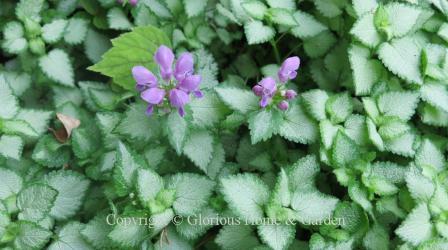 Lamium maculatum 'Beacon Silver'
Lamium maculatum 'Beacon Silver'Lamprocapnos spectabilis, bleeding heart, Zones 2-8. (Formerly Dicentra spectabilis) One of the most charming wildflowers for the woodland garden, the shape of this Japanese native is unique. Arching racemes of little puffed hearts of pink and white are a delight in the woodland garden and are a great companion for ferns, hostas, epimediums, Virginia bluebells, and trilliums. Bleeding hearts like shady and cool conditions (though not total shade), and moist, humusy woodland soil. They can perform quite spectacularly in the North. The foliage may go dormant in the summer if the plant does not get enough moisture. There is a white selection, ‘Alba,’ and a red cultivar called ‘Valentine.’ An interesting new cultivar with chartreuse foliage and pink flowers is called ‘Gold Heart.’
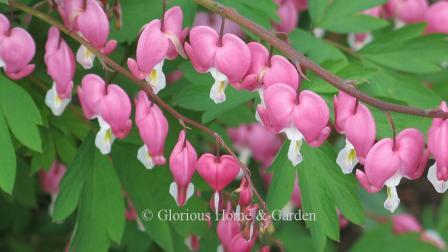 Lamprocapnos spectabilis (formerly known as Dicentra spectabilis)
Lamprocapnos spectabilis (formerly known as Dicentra spectabilis)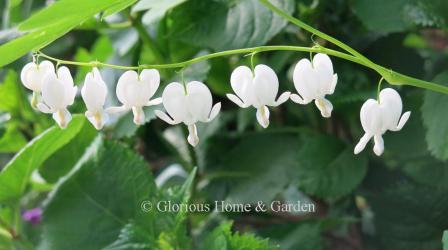 Lamprocapnos spectabilis 'Alba'
Lamprocapnos spectabilis 'Alba'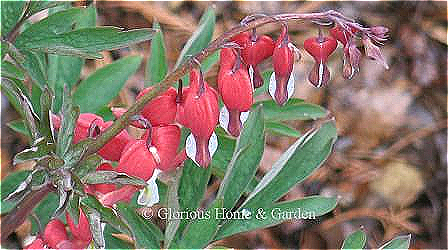 Lamprocapnos spectabilis 'Valentine'
Lamprocapnos spectabilis 'Valentine'Linum perenne, perennial flax, Zones 4-8. Flax has been grown and used to make linen fabric for centuries, but it also makes a beautiful garden plant with its azure blue flowers. Grown in full sun to partial shade in soil with good drainage it will bloom from mid-spring into summer.
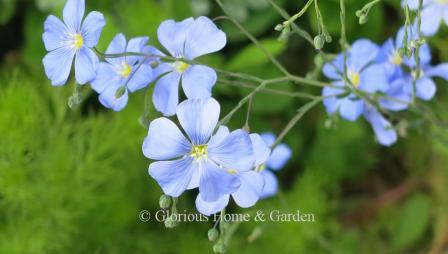 Linum perenne
Linum perenneLupinus, hybrid lupines, Zones 3-7. On a recent trip to England, I saw many gorgeous plantings of lupines such as these at Hidcote Manor. The clear colors of white, cream, yellow, pink, rose, red, purple, blue and violet, are lovely, and they stand at attention without any staking. Most of the spectacular garden varieties of lupines were developed by English hybridizer, George Russell, using North American species, resulting in dense spikes of pea-like flowers, sturdy stems and a rainbow of colors. The palmate leaves are attractive, too. Alas, they are not for the heat and humidity of the South, so if I want them, I must treat them as annuals. Easily grown from seed, lupines like full sun, and sandy soil which allows their taproots to penetrate deeply.
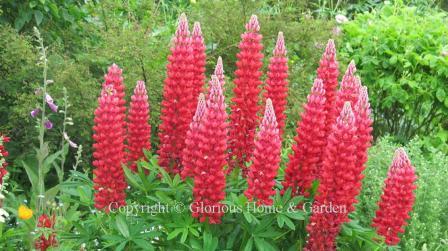 Russell hybrid lupine
Russell hybrid lupineLychnis coronaria, rose campion, Zones 4-7. Strong magenta flowers arise from soft silvery-gray foliage. This is a plant that will not be ignored, as the color shouts from across the garden. Rose campion is more of a biennial than a true perennial; however, the plant reseeds itself profusely so you will never be without once planted. In northern gardens, it is best treated as an annual. Nice in combination with white, of course, or with other hot colors like orange or purple. There is also a white one, L. coronaria 'Alba,' if a softer look is needed, or ‘Angels’ Blush’ with white petals flushed pink in the center
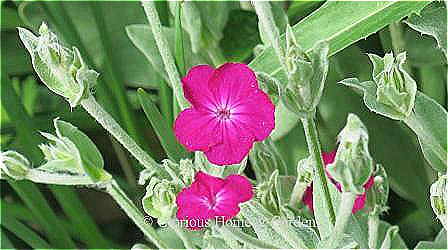 Lychnis coronaria
Lychnis coronaria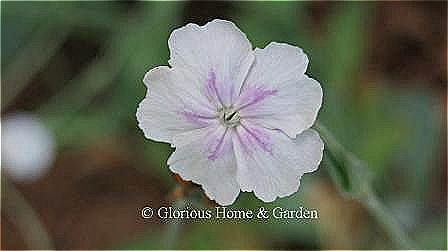 Lychnis coroniara 'Angel's Blush'
Lychnis coroniara 'Angel's Blush'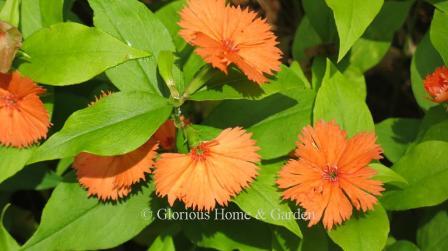 Lychnis coronaria 'Orange Sherbet'
Lychnis coronaria 'Orange Sherbet'Lychnis flos-cuculi, ragged robin, Zones 3-9. Ragged robin is a good commons name for this plant. The fringe-y flowers give it a quite different appearance from Lychnis cornonaria. Grow ragged robin in a sunny spot with moist soil. Like Lychnis coronaria, this one also self-seeds prolifically.
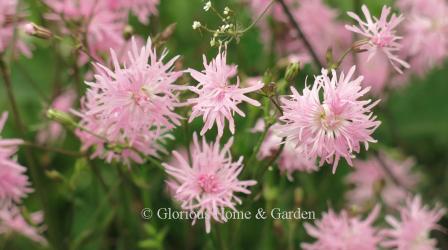 Lychnis flos-cuculi 'Jenny'
Lychnis flos-cuculi 'Jenny'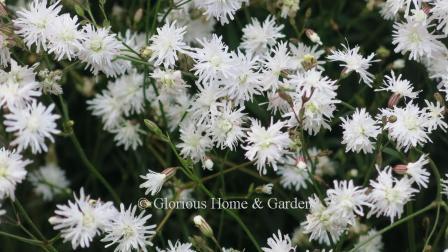 Lychnis flos-cuculi 'Petit Henri'
Lychnis flos-cuculi 'Petit Henri'Return to spring perennials A-D.
Return to spring perennials M-Z.
Plant of the Month
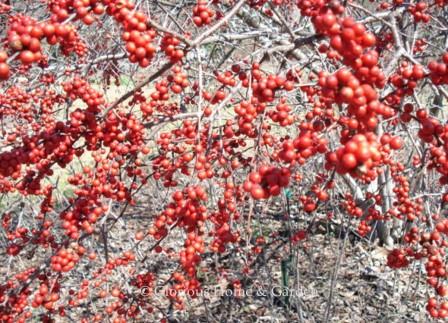
Ilex verticillata
Winterberry holly
Updated new USDA Plant Hardiness Zone Map 2023.